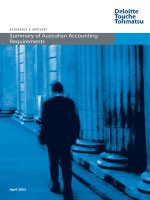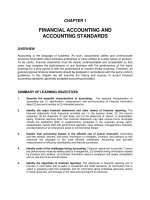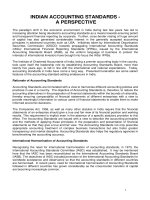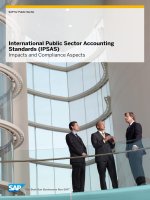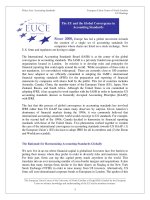01Financial accounting and accounting standards
Bạn đang xem bản rút gọn của tài liệu. Xem và tải ngay bản đầy đủ của tài liệu tại đây (489.47 KB, 51 trang )
Intermediate
Financial Accounting I
Financial Accounting and
Accounting Standards
Objectives of the Chapters
1. Understand the need to develop
accounting standards.
2. Study the development of accounting
standards from a historical perspective.
3. The GAAP and the FASB Accounting
Standards Codification.
4. Study the roles of the AICPA and the
SEC in developing GAAP.
5. Introduce the accounting standard
setting process of the FASB.
Environment and Theoretical Structure of Financial Accounting
2
Objectives of the Chapters (contd.)
6. Study the relationship between the
changes in the economic environment
and the development of accounting
standards.
7. Understand the economic
consequence of accounting
standards.
8. Understand the accounting standard
compliance system in the U.S. (a
Public/Private partnership)
Environment and Theoretical Structure of Financial Accounting
3
Objectives of the Chapters (contd.)
9. Discuss financial reporting reform and
the Sarbanes and Oxley Act (the Public
Company Accounting Reform and Investor
Protection Act of 2002)
10. Study the need for international
accounting standards and the
convergence of the U.S. accounting
standards with the International
Accounting Standards.
Environment and Theoretical Structure of Financial Accounting
4
Financial Reporting: An Introduction
and Historical Development
1. What is accounting?
2. How do we communicate financial
information?
Tools: Four financial statements.
3. How do we prepare financial statements?
Identify, measure and record business
transactions for business entities.
Journal entries, posting to ledger accounts,
work sheet (including adjustments…), F/S,
…
4. Why do we need accounting standards?
Environment and Theoretical Structure of Financial Accounting
5
What is Accounting ?
An information system to account for all
business transactions and translate
these transactions into accounting
terms to be reported in financial
statements for interested users.
Environment and Theoretical Structure of Financial Accounting
6
Accounting Standards
Accounting methods with substantial
authoritative support to be used by
business entities in preparing external
reports for users.
Environment and Theoretical Structure of Financial Accounting
7
Issues Related to Accounting
Standards
1. Who are the authorities to set these
standards (Generally Accepted
Accounting Principles, GAAP)?
2. What are these standards?
What is FASB Codification?
3. The roles of the AICPA and the SEC in
developing GAAP.
4. The accounting standard setting process
of the FASB.
Environment and Theoretical Structure of Financial Accounting
8
Year
1934
Authority Official Release
Congress
SEC
Regulation S-X
ASR and FRR
Staff Accounting Bulletins
1938
Accounting Profession
AICPA
1938-1959
CAP ………
ARBs (51)
1959-1973
APB ………
APB Opinions (31)
1973
FASB ……. 1. Statement of Financial
Accounting Standards
2. Interpretations
3. Concepts of Financial
Accounting
Environment and Theoretical Structure of Financial Accounting
9
Pronouncements of the FASB
1. Statement of Financial Accounting
Standards (SFAS)
2. Interpretations
3. Abstracts of EITF (Emerging Issue
Task Force)
4. Technique Bulletins/Staff Positions
5. Statements of Financial Accounting
Concepts
Environment and Theoretical Structure of Financial Accounting
10
GAAP
(General Accepted Accounting Principles)
Accounting methods having “substantial
authoritative support” and used by
business entities in preparing financial
statements.
Environment and Theoretical Structure of Financial Accounting
11
U.S. GAAP (contd.)
Includes:
1. FASB statements (1973 - Present)
2. FASB Interpretations ( 1973 - Present)
3. APB Opinions (1959 - 1973)
4. APB Interpretations (1959 - 1973)
5. CAP, ARBs (1938 - 1959)
6. Other Authoritative Pronouncements (i.e.,
ASR & FRR of the SEC, Technique
Bulletins/Staff Positions of FASB, and Staff
Acct. Bulletins of the SEC, Abstracts of
EITF, SOP of the AICPA, etc.)
Environment and Theoretical Structure of Financial Accounting
12
FASB Accounting Standards
Codification (ASC) (Source: SFAS 168)
Effective July 1, 2009, FASB Accounting
Standards Codification became the
single source of authoritative,
nongovernmental US GAAP.
The pronouncements of the SEC are
also sources of authoritative GAAP for
SEC registrants.
Environment and Theoretical Structure of Financial Accounting
13
FASB Accounting Standards
Codification (ASC) (Contd.)
All other non-grandfathered, non-SEC
accounting literature NOT included in the
Codification will be non-authoritative.
The Codification does not change GAAP
but only the way the existing accounting
standards are organized.
Environment and Theoretical Structure of Financial Accounting
14
What Are Included in the FASB Codification?
(Source: The FASB Accounting Standard Codification : Notice
to Constituents About the Codification)
The Codification includes:
FASB: Statements (FAS), Interpretations,
(FIN)Technical Bulletins (FTB), Staff
Positions(FSP) and Staff Implementation
Guides (Q&A).
EITF: Abstracts and Topic D
Derivative Implementation Group Issues
APB Opinions
ARB
Environment and Theoretical Structure of Financial Accounting
15
What Are Included in the FASB Codification?
(Continued)
AICPA: Statements of Position(SOP),
Audit and Accounting Guides (accounting
content only) and Practice Bulletins (PB).
SEC: Regulation S-X, FRR, ASR,
Interpretive Releases, SEC Staff
Guidance in Staff Accounting
Bulletins(SAB), EITF topic D and SEC
Staff Observer comments.
Environment and Theoretical Structure of Financial Accounting
16
What Are Not Included in the FASB
Codification? (source: The FASB Codification
Project by J. Cathey)
The followings are excluded from the
Codification:
a)SEC content not specifically directed to
financial reporting (i.e., MD&A guidance)
b)Governmental accounting standards and
auditing standards, tax codes
c)Concepts Statements of FASB
Environment and Theoretical Structure of Financial Accounting
17
FASB Codification: the Codification
Research System (Source: SFAS 168)
Codification Research System (CRS). is
an online database developed by the FASB
to allow users to access the Codification
(and therefore, authoritative GAAP) online.
CRS uses a numerical index system in
which numerical numbers are used to
correspond with topics, subtopics, sections
and paragraphs.
Environment and Theoretical Structure of Financial Accounting
18
FASB Codification: An Example
(see Illustration 1-5 on p15)
Example (source: p14 of textbook)
Search GAAP for the subsequent
measurement for loans and trade receivables
not held for sale (Codification 310-10-35-47):
Topic: ASC 310 (Receivable topic)
Subtopics: ASC 310-10 (for Overall subtopic)
Sections: ASC 310-10-35 (to access the
Subsequent Measurement Section)
Paragraph: ASC 310-10-35-47 (to assess the
Loans and Trade Rece. Not Held for Sale
Para.)
Environment and Theoretical Structure of Financial Accounting
19
FASB Codification: An Example
Environment and Theoretical Structure of Financial Accounting
20
The Role of the AICPA On Standard
Setting
1939 - 1959
1959 - 1973
1973 - Present
CAP
ARBs
APB
Opinions
1. Issue Papers (by AcSEC)a
2. Statements of Position
3. Practice Bulletins
4. Auditing Standards (by the
Auditing Standards Board)
(Replaced by PCAOB in 2002)
a. The Accounting Standards Executive Committee which was
established within the Accounting Standard Division of the
AICPA.
Environment and Theoretical Structure of Financial Accounting
21
The Accounting Standard Setting Process
of the FASB (A Due Process) (source:
FASB 2011 Website(See Illustration 1-3 on p11)
1. The Board identifies an accounting
issue based on requests received
from various sources.
2. The Chairman decides whether to add
a project to the technical agenda after
consulting with other members and
subject to oversight by the
Foundation’s Board of Trustees.
Environment and Theoretical Structure of Financial Accounting
22
The Accounting Standard Setting
Process of the FASB (A Due Process)
3. The Board deliberates various issues
identified and analyzed by the staff at
one or more public meetings.
4. The Board issues an Exposure Draft
to seek input from interested parties.
(In some case, the Board may issue a
Discussion Paper to obtain comments
prior to issuing the Exposure Draft.)
Environment and Theoretical Structure of Financial Accounting
23
The Accounting Standard Setting
Process of the FASB (A Due Process)
5. The Board holds a public roundtable
meeting on the Exposure Draft, if
necessary.
6. The staff analyzes comment letters,
public roundtable discussion, and any
other information . The Board
redeliberates the proposed
provisions at one or more public
meetings.
7.
Environment and Theoretical Structure of Financial Accounting
24
The Accounting Standard Setting
Process of the FASB (A Due Process)
7. The Board issues an Accounting
Standards Update to amend ASC by a
simple majority vote (i.e., four of the
seven board members).
Note: effective 1/2011, FASB
members expanded from 5 to 7).
Environment and Theoretical Structure of Financial Accounting
25
